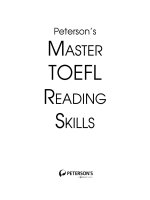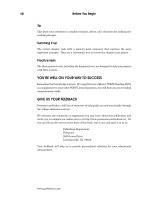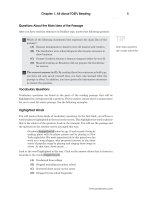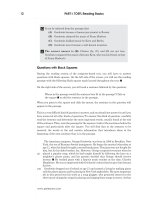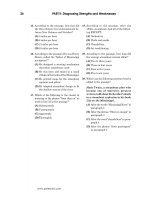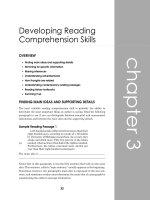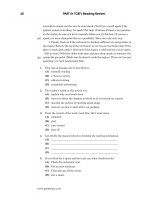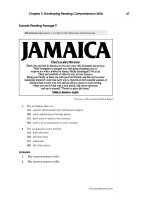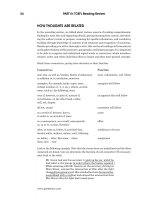Peterson’s master toefl reading skills part 5 potx
Bạn đang xem bản rút gọn của tài liệu. Xem và tải ngay bản đầy đủ của tài liệu tại đây (81.46 KB, 7 trang )
Chapter 2: Practice Test 1: Diagnostic 19
www.petersons.com
diagnostic test
PRACTICE TEST 1: DIAGNOSTIC
50 Questions • Time: 25 Minutes
Directions: Each passage is followed by a series of questions. Answer the
questions based on the information you gathered from the passage. Choose
the best answer to each question and answer each question based on what is
stated or implied in the passage.
QUESTIONS 1–10 REFER TO THE FOLLOWING
PASSAGE.
The cabildo, which is Spanish for “mu-
nicipal council,” was the fundamental
unit of local government in colonial Span-
ish America. Following a tradition going
back to the Romans, the Spanish consid-
ered the city to be of paramount impor-
tance, with the surrounding country-
side directly subordinate to it.
In local affairs, each municipality in
Hispanic America was governed by its
cabildo, or council, in a manner reminis-
cent of Castilian towns in the late Middle
Ages. A council’s members and magis-
trates, together with the local judge ap-
pointed by the king, enjoyed considerable
prestige and power. The size of a council
varied but was always small. The cabildos
of important cities, such as Lima and
Mexico, had about 12 members.
The cabildo was in charge of all ordi-
nary aspects of municipal government—
e.g., policing, sanitation, taxation, the
supervision of building, price and wage
regulation, and the administration of
justice. To assist them in these responsi-
bilities, the city councilors appointed
various officials, such as tax collectors,
inspectors of weights and measures and
the markets, and peace officers. In spite
of royal decrees to promote honest and
efficient city government, the cabildos
were often corrupt and rapacious.
By the mid-sixteenth century, appoint-
ments to cabildos were ordinarily made
by the Spanish crown and sometimes
became hereditary. Occasionally, the
propertied class in a city elected some of
the councilors. Sometimes citizens were
asked to attend a open town meeting on
important matters. Such open meetings
became very important to the movement
for the independence of Hispanic America
in the early nineteenth century.
1. Which choice does the word “paramount”
as used in line 6 refer to?
(A) Fundamental
(B) Government
(C) Tradition
(D) Surrounding
2. Where was the cabildo used as a form of
government?
(A) In Roman colonies
(B) In Spanish colonies
(C) In Roman provinces
(D) In Spanish provinces
3. Which of the following answer choices is
closest in meaning to the word “reminis-
cent” as used in lines 11–12?
(A) Suggesting something in the past
(B) Suggesting a schedule or agenda
(C) Suggesting a small village
(D) Suggesting an odor
4. According to the passage, how was a local
judge in Hispanic America selected?
(A) He was elected by the council.
(B) He was appointed by the king.
(C) He was chosen by the town’s wealthy
citizens.
(D) He was the richest man in the town.
(5)
(10)
(15)
(20)
(25)
(30)
(35)
(40)
02_TOEFL Reading Ch 2,15-28 7/29/06, 11:4919
20 PART II: Diagnosing Strengths and Weaknesses
www.petersons.com
5. According to the passage, how many coun-
cilors did Lima have?
(A) Ten
(B) Eleven
(C) Twelve
(D) Thirteen
6. From the passage it can be inferred that
some cabildos were
(A) poorly educated
(B) important
(C) corrupt
(D) independent
7. What word does the phrase “peace offic-
ers” as used in line 29 refer to?
(A) Sanitation
(B) Policing
(C) Assist
(D) Tax collectors
8. Which is closest in meaning to the word in
the passage “responsibilities” as used in
lines 25–26?
(A) Duties
(B) Wages
(C) Sanitation
(D) Inspections
9. From the passage it can be inferred that
by the mid-sixteenth century, the cabildo
was all of the following EXCEPT:
(A) Elected by all registered voters
(B) Appointed by the king
(C) Came from the propertied class
(D) Was an inherited office
10. Where can the following sentence best be
added to the passage?
Debates were sometimes heated, and
the wealthy landowners had to de-
fend their positions by arresting their
opponents.
(A) At the end of paragraph 1
(B) At the end of paragraph 2
(C) After the words “peace officers” in
paragraph 3
(D) After the words “important matters”
in paragraph 4
QUESTIONS 11–20 REFER TO THE
FOLLOWING PASSAGE.
Annie Oakley, an intriguing figure in
American entertainment, was a
markswoman who starred in Buffalo
Bill’s Wild West Show, where she was
often called “Little Sure Shot.” She was
born in 1860 in Darke County, Ohio, and
her original name was Phoebe Ann
Moses. As a child, she hunted game with
such success that, according to legend,
by selling it in Cincinnati, Ohio, she was
able to pay off the mortgage on the
family farm. When she was 15 she won
a shooting match in Cincinnati with
Frank E. Butler, a vaudeville marks-
man, and they were married a year later.
For the next ten years they toured the
country and performed in theaters and
circuses as “Butler and Oakley.” In April
1885, Annie Oakley, now under her
husband’s management, joined “Buffalo
Bill” Cody’s Wild West Show. Billed as
“Miss Annie Oakley, the Peerless Lady
Wing-Shot,” she was one of the show’s
star attractions for sixteen years.
Oakley never failed to delight her audi-
ences, and her feats of marksmanship
were truly incredible. At 30 paces she
could split a playing card held edge-on,
and she hit dimes tossed into the air.
She shot cigarettes from her husband’s
lips, and, when he threw a playing card
into the air, she would shoot it full of
holes before it touched the ground. She
was a great success on the Wild West
Show’s European trips.
(5)
(10)
(15)
(20)
(25)
(30)
(35)
02_TOEFL Reading Ch 2,15-28 7/29/06, 11:4920
Chapter 2: Practice Test 1: Diagnostic 21
www.petersons.com
diagnostic test
In 1887, she was presented to Queen
Victoria, and later in Berlin she per-
formed her cigarette trick with, at his
insistence, Crown Prince Wilhelm (later
Kaiser Wilhelm II) holding the ciga-
rette. A train wreck in 1901 left her
partially paralyzed for a time, but she
recovered and returned to the stage to
amaze audiences for many more years.
11. Which of the following is closest in meaning
to the word “intriguing” as used in line 1?
(A) Frightening
(B) Fascinating
(C) Fabulous
(D) Funny
12. What was Oakley often called while per-
forming in Buffalo Bill’s Wild West Show?
(A) Little Orphan Annie
(B) Little Phoebe Ann
(C) Little Sure Shot
(D) Little Phoebe Butler
13. Which of the following is the closest in
meaning to the word “mortgage” as used
in line 11?
(A) A debt left by a deceased property owner
(B) A bank-loan contract using property
as security
(C) A measurement of debts owed
(D) A piece of furniture loaned to a neighbor
14. What does the word “it” as used in the
phrase “by selling it” in line 10 refer to?
(A) Child
(B) Game
(C) Legend
(D) Mortgage
15. The passage implies that Oakley and
Butler were married in
(A) 1873
(B) 1874
(C) 1875
(D) 1876
16. According to the passage, Frank E. Butler
was all of the following EXCEPT:
(A) Annie Oakley’s assistant in her act
(B) Annie Oakley’s husband
(C) Annie Oakley’s teacher
(D) Annie Oakley’s manager
17. Which of the following is closest in mean-
ing to the word “feats” as used in line 26?
(A) Jokes
(B) Accomplishments
(C) Displays
(D) Mistakes
18. Where can the following sentence best be
added to the passage?
Her story was made into a Broadway
musical called Annie Get Your Gun,
but the real life of Annie Oakley is
just as interesting.
(A) After the phrase “Little Sure Shot” in
paragraph 1
(B) After the phrase “Butler and Oakley”
in paragraph 2
(C) At the end of paragraph 3
(D) At the beginning of paragraph 4
19. According to the passage, who performed
the cigarette trick with her in Europe?
(A) Queen Victoria
(B) Crown Prince Wilhelm
(C) Buffalo Bill Cody
(D) Princess Anne
20. Which of the following can be inferred
from the passage?
(A) Annie Oakley was a talented and
popular entertainer.
(B) Frank E. Butler was jealous of his
wife’s talent and popularity.
(C) Queen Victoria was brave when she
held a cigarette for Annie Oakley.
(D) Buffalo Bill Cody was not as good a
marksman as Annie Oakley.
(40)
02_TOEFL Reading Ch 2,15-28 7/29/06, 11:4921
22 PART II: Diagnosing Strengths and Weaknesses
www.petersons.com
QUESTIONS 21–30 REFER TO THE
FOLLOWING PASSAGE.
Edward Patrick Eagan was born April
26, 1897, in Denver, Colorado, and his
father died in a railroad accident when
Eagan was only a year old. He and his
four brothers were raised by his mother,
who earned a small income from teach-
ing foreign languages.
Inspired by Frank Merriwell, the hero
of a series of popular novels for boys,
Eagan pursued an education for himself
as well as an interest in boxing. He
attended the University of Denver for a
year before serving in the U.S. Army as
an artillery lieutenant during World War
I. After the war, he entered Yale Univer-
sity and, while studying there, won the
U.S. national amateur heavyweight box-
ing title. He graduated from Yale in
1921, attended Harvard Law School,
and received a Rhodes scholarship to the
University of Oxford where he received
his A.M. in 1928.
While studying at Oxford, Eagan be-
came the first American to win the Brit-
ish amateur boxing championship.
Eagan won his first Olympic gold medal
as a light heavyweight boxer at the 1920
Olympic Games in Antwerp, Belgium.
Eagan also fought at the 1924 Olympics
in Paris as a heavyweight but failed to
get a medal. Though he had taken up the
sport just three weeks before the compe-
tition, he managed to win a second gold
medal as a member of the four-man
bobsled team at the 1932 Olympics in
Lake Placid, New York. Thus he became
the only athlete to win gold medals at
both the Summer and Winter Olympics.
Eagan was a member of the first group
of athletes inducted into the U.S. Olym-
pic Hall of Fame in 1983. Eagan became
a respected attorney, serving as an as-
sistant district attorney for southern
New York and as chairman of the New
York State Athletic Commission (1945–
51). He married soap heiress Margaret
Colgate and attained the rank of lieu-
tenant colonel during World War II.
21. What is the main idea of the passage?
(A) Eagan’s life shows how a wealthy stu-
dent can achieve as much as a poor one.
(B) Eagan’s life shows that military expe-
rience makes athletes great.
(C) Eagan’s life shows that a man can be an
athlete and a well-educated person.
(D) Eagan’s life shows how easy it is to
win two gold medals in different Olym-
pic sports.
22. According to the passage, who was Frank
Merriwell?
(A) A teacher at Yale
(B) A fictional character
(C) A student at Oxford
(D) A bobsledder at the Olympics
23. According to the passage, how did Eagan’s
mother earn a living?
(A) Renting rooms to immigrants
(B) Teaching foreign languages
(C) Doing laundry and cleaning
(D) Writing fiction for women’s magazines
24. Which of the following is the closest in
meaning to the word “artillery” as used in
line 14?
(A) Large weapons such as cannons
(B) Small weapons such as pistols
(C) Shoulder weapons such as rifles
(D) Tension weapons such as crossbows
25. According to the passage, Eagan won all
of the following EXCEPT:
(A) Light heavyweight boxing, Olympic
gold medal
(B) U.S. national amateur heavyweight
boxing title
(C) British amateur boxing championship
(D) Heavyweight boxing, Olympic gold
medal
(5)
(10)
(15)
(20)
(25)
(30)
(35)
(40)
(45)
02_TOEFL Reading Ch 2,15-28 7/29/06, 11:4922
Chapter 2: Practice Test 1: Diagnostic 23
www.petersons.com
diagnostic test
26. According to the passage, where were the
1920 Olympic Games held?
(A) Antwerp, Belgium
(B) Paris, France
(C) London, England
(D) Lake Placid, New York
27. Where can the following sentence best be
added to the passage?
He continued to be active in amateur
athletics for the rest of the decade.
(A) At the end of paragraph 1
(B) After the word “boxing” in paragraph 2
(C) After the phrase “get a medal” in
paragraph 3
(D) At the end of paragraph 4
28. Which word or phrase does the word “com-
petition” as used in lines 32–33 refer to?
(A) Sport
(B) Gold medals
(C) 1932 Olympics
(D) Summer Olympics
29. According to the passage, what was
Eagan’s profession?
(A) He was a boxing trainer.
(B) He was an attorney.
(C) He was an army officer.
(D) He was president of Colgate.
30. According to the passage, what special
honor did Eagan receive in 1983?
(A) He was inducted into U.S. Olympic
Hall of Fame.
(B) He was promoted to lieutenant colo-
nel in the U.S. Army.
(C) He received a gold medal in four-man
bobsledding.
(D) He was appointed assistant district
attorney for Southern New York.
QUESTIONS 31–40 REFER TO THE
FOLLOWING PASSAGE.
The first folio edition of the collected
works of William Shakespeare was origi-
nally published in 1623 as Mr. William
Shakespeares Comedies, Histories &
Tragedies. This folio edition is the major
source for contemporary texts of his
plays.
The publication of drama in the early
seventeenth century was usually left to
the poorer members of the Stationers’
Company and to outright pirates. The
would-be publisher only had to get hold
of a manuscript, legally or illegally, reg-
ister it as his copy, and have it printed.
Sometimes the publisher dispensed with
the formality. Such a man was Thomas
Thorpe, the publisher of Shakespeare’s
sonnets in 1609.
Titus Andronicus was the first play by
Shakespeare to be published and was
printed by a notorious literary pirate,
John Danter, who also brought out,
anonymously, a defective Romeo and
Juliet, largely from shorthand notes
made during performance. Eighteen of
Shakespeare’s plays were printed in
quartos (books about half the size of a
modern magazine) both “good” and “bad”
before the First Folio (a large-format
book) was published in 1623. The bad
quartos are defective editions, usually
with badly garbled or missing text.
For the First Folio, a formidable project
of more than 900 pages, five men formed
a partnership, headed by Edward Blount
and William Jaggard. The actors John
Heminge and Henry Condell undertook
the collection of 36 of Shakespeare’s
plays, and about 1,000 copies of the First
Folio were printed by Isaac Jaggard,
William’s son. In 1632, a second folio
was issued and in 1663, a third. The
latter included Pericles and several other
plays that may not have been written by
Shakespeare. These included The Two
Noble Kinsmen, which is now thought to
have been a collaboration of Shakespeare
and John Fletcher.
(5)
(10)
(15)
(20)
(25)
(30)
(35)
(40)
(45)
02_TOEFL Reading Ch 2,15-28 7/29/06, 11:4923
24 PART II: Diagnosing Strengths and Weaknesses
www.petersons.com
31. From the passage it can be inferred that
the First Folio of Shakespeare’s plays is
important because it
(A) was registered at the Stationer’s Of-
fice by Thomas Thorpe
(B) is the major source for contemporary
texts of Shakespeare’s plays
(C) is twice the size of the quarto edi-
tions that were badly printed by many
publishers
(D) was published three years after the
establishment of the Plymouth Colony
32. Which of the following is closest in meaning
to the word “outright” as used in line 11?
(A) Unfairly judged as something
(B) Proved to be something without
question
(C) Imprisoned without a trial
(D) Opposing the rights of an enemy
33. The passage implies that many publishers
(A) were unsuccessful authors themselves
(B) printed the work of only the best writers.
(C) used an author’s work without per-
mission
(D) paid the author very well for his
writing
34. Which of the following is closest in mean-
ing to the phrase “dispensed with” as used
in line 15?
(A) Gave away to customers
(B) Managed without something
(C) Wrote a denial to an accusation
(D) Compensated another’s loss
35. According to the passage, when were
Shakespeare’s sonnets published?
(A) 1609
(B) 1610
(C) 1611
(D) 1612
36. Which word is closest in meaning to the
phrase “brought out” as used in line 22?
(A) Published
(B) Printed
(C) Performed
(D) Defect
37. According to the passage, how many of
Shakespeare’s plays were printed in
quartos?
(A) 17
(B) 18
(C) 19
(D) 20
38. The passage implies that John Danter
acquired the text of Romeo and Juliet by
(A) paying an actor for a copy of the script
(B) buying the copyright from Shakespeare
(C) taking notes during a performance
(D) hiring an actor to recite the lines to
him
39. According to the passage, all of the follow-
ing were involved in the publishing of the
First Folio EXCEPT:
(A) Edward Blount
(B) Henry Condell
(C) William Jaggard
(D) John Danter
40. Where can the following sentence best be
added to the passage?
They sold quickly to a public anxious
to have accurate copies of the master
dramatist’s plays.
(A) At the end of paragraph 1
(B) After the word “formality” in para-
graph 2
(C) After the word “performance” in para-
graph 3
(D) After the phrase “William’s son” in
paragraph 4
02_TOEFL Reading Ch 2,15-28 7/29/06, 11:4924
Chapter 2: Practice Test 1: Diagnostic 25
www.petersons.com
diagnostic test
QUESTIONS 41–50 REFER TO THE
FOLLOWING PASSAGE.
Steamboats were shallow-draft boats
propelled by steam-driven paddle
wheels. In the nineteenth century, they
could be seen every day on rivers, par-
ticularly on the Mississippi River and its
principal tributaries in the United
States.
The development of the steamboat as a
practical means of transportation began
in America in 1787, but it wasn’t until
1811 that a steamboat was built specifi-
cally to travel along the lower Missis-
sippi River. The boat, called appropri-
ately the New Orleans, was built at
Pittsburgh, Pa., for Robert Fulton and
Robert R. Livingston. In 1812, the two
men began operating a regular steam-
boat service between New Orleans and
Natchez, Mississippi. Their vessels trav-
eled at eight miles per hour downstream
and three upstream.
In 1816, Henry Miller Shreve launched
his steamboat Washington, and soon
became known as the father of Missis-
sippi navigation, because he adapted
steamboat design to fit the shallow wa-
ters of the river. He installed the engine
high up above the water line and
mounted it on a hull that was as shallow
as that of a barge. He also added a tall
second deck, and afterwards all Missis-
sippi steamboats copied Shreve’s design.
From then on and until about 1870, the
steamboat dominated the economy, ag-
riculture, and commerce of the middle
area of the United States.
By 1834, there were 1,200 steamboats,
carrying not only cotton and sugar, but
also passengers who enjoyed luxuriously
appointed lounges with rich rugs, oil
paintings, and chandeliers. Many steam-
boats were famous for their chefs, or-
chestras, and large staffs of maids and
butlers to assist their cabin passengers.
Steamboat pilots had to memorize or
guess at the depths of the river and its
potential obstacles along long stretches
of river in order to navigate safely. The
average life span of a steamboat was
only four to five years, because most of
the vessels were poorly constructed and
maintained. They sank after hitting sand
bars and hidden rocks in the river, and
many of their boilers exploded, causing
many deaths among their passengers.
By the 1870s, railroads had become more
efficient modes of transport and gradu-
ally caused the retirement of almost all
the steamboats from the river.
41. In the passage, it is implied that steam-
boats were used mainly
(A) in New Orleans
(B) in Washington, D.C.
(C) along the Hudson River
(D) in the Mississippi River valley
42. Which of the following is closest in mean-
ing to the word “tributaries” as used in
line 6 of the passage?
(A) A party honoring a famous person
(B) A stream that flows into another
(C) A three-wheeled vehicle
(D) A state that has a border on three
other states
43. According to the passage, in what year
were steamboats operating regularly on
the Mississippi?
(A) 1810
(B) 1811
(C) 1812
(D) 1813
44. Which of the following does the phrase
“means of transportation” as used in line
9 refer to?
(A) Steamboat
(B) America
(C) Built specifically
(D) Travel
(5)
(10)
(15)
(20)
(25)
(30)
(35)
(40)
(45)
(50)
(55)
02_TOEFL Reading Ch 2,15-28 7/29/06, 11:4925
